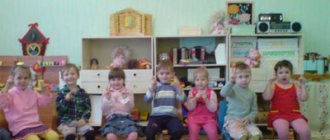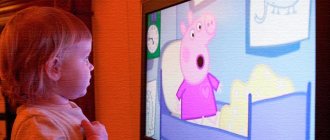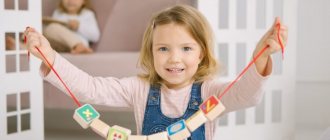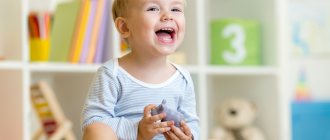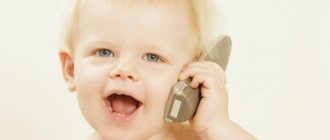Norms of speech development
- Child 1 to 1.5 years old. At this age, children use individual words in conversation. By the age of one and a half years, the child composes simple sentences. For example, “give me some porridge” or “give me some water.” The child remembers the names of objects that surround him at home, as well as several basic verbs and adjectives.
- Child from 1.5 years to 2 years. Toddlers' vocabulary is expanding rapidly. Shortened forms of words are gradually disappearing. Children's speech becomes coherent thanks to pronouns and adjectives. By the age of two, the child begins to use sentences of 3-4 words. The more we develop children’s speech at home, the more expressive and emotional it becomes.
- Child from 2 years to 2.5 years. While studying the speech of your children, you can move on to simple poetry. At this age, kids remember quatrains well. Vocabulary increases due to the rapid acquisition of new phrases and expressions. Questions appear in coherent speech. The number of words in sentences increases due to conjunctions and prepositions. The child begins to communicate not only with parents, but with peers.
- Child from 2.5 years to 3 years. Children begin to understand the meaning of speech well. They can delve into stories about future and past time. The more often we develop children’s speech at home at this age, the faster their vocabulary increases. Parents become a source of information. Children can be assigned tasks that involve several activities. If we develop speech correctly, then numerals and cases appear in it.
- Child from 3 to 4 years old. Sound pronunciation improves. The child can talk about himself and correctly uses comparative adjectives, verb tenses and gender. Children are given generalizations (furniture, people, etc.). Vocabulary includes not only objects available at home, but also abstract concepts, phenomena and evaluations. At this age, we develop speech with the help of books and poems. Children like to reread the same thing several times, since familiar information is absorbed better. The child is able to memorize prose and poetry verbatim. However, retelling is difficult.
- Child from 4 to 5 years old. Children's vocabulary is rapidly growing due to adverbs. The child becomes interested in independently analyzing words, transferring their formation to others. Although it doesn’t always turn out correctly (“cuter is cuter”, “bright is brighter”). By the age of five, a child can use the plural fluently. However, when encountering unfamiliar words, children may have problems (“cucumber – cucumbers – cucumbers”). The child’s coherent speech is not yet sufficiently developed. When retelling events, inconsistency is acceptable. At this age, it is necessary to develop the child’s speech, working on the sound pronunciation of sonorant and hissing sounds.
- Child from 5 to 6 years old. At this age, correct coherent speech is actively developing. Children are able to compose stories based on visual material, retell stories in compliance with tenses and logical chains. Inner speech is formed, so children have the ability to plan their actions. Gross grammatical errors disappear. You will no longer hear from your child: “I’ll go to the store yesterday.” Sound pronunciation and sound analysis are normalized. The child’s speech becomes more expressive, accompanied by changes in intonation and volume.
- Child from 6 to 7 years old. Children fully master coherent speech. Sounds are pronounced correctly, temporal and logical sequences are observed. Errors occur only in complex sentences.
- Child from 7 to 8 years old. Stable and figurative expressions are added to coherent speech. The kid is able to read a poem with an expression, as well as explain its meaning. A child at the age of 8 begins to actively master reading and writing. By this age, he has developed all the skills necessary for studying at school. As a rule, at this stage, adults do not have the question of how to develop a child’s speech.
If a child does not have developed speech for his age group, then specialist help may be required. It is better to contact a speech therapist or preschool teacher. It is also necessary to develop the baby’s speech at home.
What influences speech development?
The following factors influence the development of speech in a child:
1. Auditory attention
. If speech hearing develops rapidly, this usually slows down the development of auditory sensitivity. Meanwhile, the rate of development of phonemic hearing is influenced by musical, in particular, sound-frequency hearing. That is why it is important for parents not only to talk to their baby, but also to sing for them or play music in the background.
2. Motor development
. There is a direct connection between language and motor development. Therefore, in order to speed up the process of forming one, it is necessary to develop the other. Children master speech skills much faster in games that use all the senses and muscles of the body. It is important to ensure that they control muscle movements, especially small ones.
3. Intellectual growth
. If a child utters words or phrases that seem stupid to parents, this should not be assessed as a low level of intelligence. With the help of “their” vocabulary, young children express thoughts, desires, associations, and views on the world. By correcting mistakes, adults thereby prevent the speech apparatus from developing.
4. Emotional development
. The speed of development of speech functions largely depends on the child’s emotional contact with adults. Feeling a connection with his parents, he strives to repeat their words or actions. Children who do not have this contact or who have experienced emotional stress have a much more difficult time speaking early.
5. Communication
. To develop speech, a child must have a desire to communicate with others. After all, speech skills are needed not only to express your emotions and thoughts. It is by communicating with adults that children expand their vocabulary and develop speech functions.
General Tips
Speech therapists give young parents the following general recommendations to speed up their baby’s speech development:
- Talk constantly.
Immediately after birth, a child is ready to absorb information, like a sponge, about what he sees, feels, and hears. A newborn's hearing is already fully formed. Talk about anything, where you went, who came, comment on any little thing. Actions that are accompanied by words lead to a quick understanding of speech and words. After a short time, the baby will be able to understand what they want from him using words that are not reinforced by actions.
- Repeat after your baby
. Children in infancy try to say something. This usually looks like an endless repetition of some sound. In this way, the child’s diction is trained. At this age, it is better for parents to repeat after him. You can gradually complicate the task by humming familiar sounds for your baby, “dya-dya-dya.” This way he will learn to keep up the pace. This will also be important for the further formation of speech.
- Show what sounds animals make.
If there is a cat at home we say “meow”, if a dog says “woof”. In this way, the child will quickly master the sounds made by animals. After the speech apparatus is formed, he will cope with calling the cat in the usual way “kitty-kitty”. If there are no animals in the house, then reinforce the sounds with pictures.
- Develop fine motor skills
. If you pay attention, you will notice that small children want to touch everything with their own hands. This is how their brain develops. If you develop fine motor skills before the age of one, then speech will develop more quickly. But, all activities with small objects must definitely be carried out under the close supervision of adults.
- Organize communication with peers.
Children communicate more actively with each other than with adults, although it looks like babbling. It would be nice if in the children's company there was a child who already knows how to speak. Thus, the baby will try to imitate him.
- Use sign language.
It is easier for a baby to show with a gesture than to say with words. Therefore, as soon as the child begins to gesture at objects, the mother should comment on this in words, and not silently give the necessary object to the child. The kid points at the juice, we say that it is juice, at the cat, we say that it is a cat.
Methods for developing active speech in young children
Formation of active speech in young children is a necessity. This is due to the sensitive period of the child’s speech development and the active growth in the number of speech pathologies in modern society. This requires the use of a variety of methods and techniques for activating the speech work of a young child.
Stimulating the active speech of a young child is realized through the use of the following methods:
- Visual methods. They are associated with the demonstration of living objects, their actions, observation of processes and phenomena of the surrounding world.
- Verbal methods. They are associated with reading children's literature, pronunciation of rhymes, nursery rhymes, fairy tales, and stories.
- Practical methods. As a rule, they include play activities. Special classes on speech development can be organized, but in this age period they do not have an active impact. Therefore, didactic games are used.
- Folklore. It is oral folk art that has an active influence on the development of a child’s active speech. Lullabies, nursery rhymes, and rhymes captivate the child and direct his attention to the adult’s speech. In addition, they stimulate the work of thought processes, which activates speech development.
- Onomatopoeia. This is a special technique aimed at activating the child’s speech work. Sounds and their combinations are given that reflect the actions of objects, the sounds of animals: ku-ka-re-ku, woof-woof, chug-chukh, top-top.
- Exercises to develop speech breathing. They are necessary in order to develop the basics of correct pronunciation. Children are given exercises to deflate and blow something out, and perform rhythmic inhalations and exhalations.
- Exercises to develop motor functions of the body. Motor skills stimulate speech development. Finger games, finger gymnastics, artistic creativity - modeling, finger painting are used.
- Sand therapy. This is an innovative method used in child development. Playing with sand promotes the development of motor functions of the body, which stimulates speech and helps form the foundations of a coherent statement.
Figure 1. Games and activities for speech development. Author24 - online exchange of student work
Stages of development of a child’s own (expressive) speech:
Screams
- arise from birth.
Booming
– prolonged pronunciation of vowels and syllables with throat consonants (gu, agu, gee) from 2 to 5-7 months.
Against the background of a melodious hum, syllables with labial and anterior lingual sounds appear
, which then transform into babble.
Babbling
– repeated repetition of syllables, with labial and frontal consonants (ma-ma-ma, boo-boo-boo) began from 4-7.5 months.
Words
- the transition is carried out against the background of ongoing babbling: babbling words (mom, dad, bobo, bang, am, give) from 11-12 months.
The appearance of words in the adult lexicon (milk - moko, mami - take, maka - small, titiki - watch) began at 1 year 7/9 months. The coexistence of words, correctly and incorrectly pronounced, is the main pattern of the initial stages of speech development in children.
Parshukova Inga Alekseevna.
Moscow, Siberian State Transport University, student,
Infancy is a period in which the development of a child in physical, mental and social terms occurs extremely quickly, covering in a short period of time a huge path from a helpless newborn with a small set of innate reactions to an active baby who is able to look, listen, act, cry for help , rejoice [1, p. 24].
It is known that the period of infancy consists of two phases (the first lasts up to 5-6 months, the second lasts up to 12 months) and ends with a crisis of one year.
The mental development of a child during infancy is determined by the fact that he is biologically and socially helpless and has minimal opportunities for communication and interaction with others. Therefore, the main direction of a child’s development at this stage is mastering the basic ways of interacting with the world.
The first phase of infancy is characterized by the active development of sensory systems, i.e. elementary forms of future orienting reactions, such as concentration, tracking, circular movements. At 4 months, a reaction to novelty appears; it consists, in particular, in the duration of holding the gaze on a new object. There is also the development of auditory perception (reaction to the mother’s voice) and tactile sensitivity, which is of great importance for the formation of the act of grasping and examining an object.
The development of a child’s vocal reactions manifests itself in the form of attempts to attract an adult through the voice, which indicates the process of restructuring vocal reactions into behavioral acts. At this time, the child exhibits various types of vocal reactions, which include hooting, humming, and babbling.
With the onset of the second phase of infancy (at approximately 5 months), a “turning point” occurs in the child’s development. Its beginning is characterized by the appearance of the first directed action - the act of grasping. For the mental development of the child, this act is extremely important, since in connection with it, objective perception arises.
Thanks to the act of grasping, the perception of space deepens (the space of an outstretched arm). Although its distance is small, at the same time, the object breaks out of the previous scheme (the perception of spatial characteristics previously occurred through the mouth).
Based on the active development of the hand, which consists of opposing the thumb, the child’s ability to manipulate an object expands. Therefore, at the age of 4 to 7 months, the child begins to perform effective actions, which is manifested in simply moving an object and extracting sounds from it.
By 7–10 months, correlative actions are formed, i.e. the child learns to interact with two objects at the same time, moving them away from himself or relating them to each other.
By the end of the infancy period (from 10-11 to 14 months), functional actions occur. These actions are characterized by more advanced movements: opening, inserting, stringing. Moreover, if previously the child carried out an action in one way, which was shown to him by an adult and performed this action on the same objects, now he attempts to reproduce the action on all kinds of objects [4].
The act of grasping stimulates the child to sit. Many other objects open before him, and objects appear that he cannot reach. This is where the law of the child’s advance acquaintance with the world comes into force. Due to the fact that the child reaches out to an object, but can only get it with the help of an adult, communication takes on a different character, it becomes communication about objects.
From the second half of life, adult help (organization of actions, approval) is important. This leads to the need for new means and ways of influencing adults. This is how a pointing gesture arises, which is already objectively related and contains the rudiments of a word.
L.S. Vygotsky determined that initially the pointing gesture is an unsuccessful act of grasping movement: the child wants to take an object that is too far from him and his hands, extended to the object, remain hanging in the air, and his fingers make pointing movements. Understanding the child's movement as a pointing gesture occurs when the mother comes to his aid. After this, the situation changes significantly and this gesture already becomes a gesture for others. That is, an unsuccessful grasping action of a child causes a reaction not from the object, but from other people. And only subsequently does the child begin to treat this movement as an instruction. The child is the last to realize his gesture [2, p. 101–104].
This process illustrates that the joint action of a child and an adult lies at the origins of the emergence of a word.
The child’s first understanding of words occurs towards the end of infancy, and an adult has the opportunity to control the child’s orientation based on his understanding of speech.
Between infancy and early childhood there is a transition period - the “one-year crisis.” The crisis begins at 9 months, at which time the child begins to walk. According to D.B. Elkonin, the main thing in the act of walking is not only the expansion of the child’s space, but also his separation from the adult. Now there is a division of “we” and for the first time it is not the mother who leads the child, but he who leads the mother wherever he wants. Walking is the first major neoplasm of infancy, which marks a break in the old developmental situation [5, p. 159].
The appearance of the first word represents the second major new formation characteristic of this age. The first words are different in that they are a continuation of pointing gestures. The beginning of walking and the gradual enrichment of objective actions create a need for speech that could satisfy communication about objects. At this stage, speech is a specific structure, which consists of fragments of words, is emotionally charged and understandable only to those close to you. Nevertheless, it serves as a criterion for the emergence of a new developmental situation: where there was unity, two appeared - an adult and a child. Between them a new content of activity arose - the world of human objects.
The third, main new development during infancy is the appearance of manipulative actions with objects. The child still has to learn to interact, master ways of acting with human objects that surround him everywhere. For now, the child has to focus on the physical properties of these objects. The exit from the old developmental situation is accompanied by the manifestation of the child’s negative emotions, which arise in the form of a response to a certain limitation of his physical independence. L.S. Vygotsky gave this behavior the name “hypobulic reactions,” that is, protest reactions in which the differentiation of will and affect has not yet occurred.
Describing the crisis of the first year of life, L.S. Vygotsky explains it by the appearance of autonomous child speech. It leads to a change in the child’s attitude towards the environment, thereby bringing into being a new developmental situation. “Speech in relation to the child’s social space plays the same role as walking in relation to the physical space” [3, p. 150].
This period is characterized by the child’s desire for independence and at the same time complete dependence on the adult, which is the main contradiction of the crisis of the first year.
Thus, this stage of child development is characterized by the fact that from the very beginning there are two interconnected lines of mental development: the formation of orientation in the meanings of human activity and the formation of orientation in the methods of human activity. Mastering one line opens up the possibility of developing another.
Thus, the main task of raising a child during infancy is the maximum expansion and development of the child’s broad orientation in the surrounding reality.
In view of the fact that emotional communication is the main type of activity of a child during infancy, it is extremely important to satisfy the first need that develops in a child - the need for another person.
To develop a child’s sense of trust in the world, adults need to communicate with him, since, with correct and sufficient communication between a child and an adult, the phonemic composition of babble forms the phonemic composition of native speech. In this case, communication should be emotionally positive.
Taking into account the above, we can conclude that the period of infancy is an important period during which the rapid formation of all mental processes occurs in the shortest possible time.
Bibliography:
- Vallon A. Psychological development of the child. - M.: Education, 1997. - 195 p.
- Vygotsky L.S. Questions of child psychology. - St. Petersburg: Soyuz, 2006. – 224 p.
- Vygotsky L.S. Pedagogical psychology. - M.: Education, 2008. - 300 p.
- Obukhova L.F. Developmental psychology: a textbook for universities. – M.: Higher education; MGPPU, 2009. – 460 p.
- Elkonin D.B. Introduction to developmental psychology. - M.: Nauka, 2009. - 168 p.
The most common mistakes made by adults
During the development of a child, the most common mistakes made by adults are:
- Overly active guardianship
. Parents strive to predict the child's wishes. He doesn't feel the need to talk. He does not learn to express his thoughts, which leads to inhibition of speech processes.
- Do not include new people in the child’s social circle
, which will subsequently lead to difficulty communicating in unusual conditions.
- Overestimation or underestimation of speech requirements
. In some families, the child does not have the need to talk against the background of absolute prediction of all his desires. Sometimes the baby is constantly asked to “repeat”, “say”. It happens that in the same family there are two approaches at once: the grandmother is overprotective, and the father demands. This adversely affects both the speech and overall development of the baby.
- Too fast or slow, monotonous speech of parents.
Emotionally uncolored speech of adults, without pauses, has a bad effect on the development of children's speech.
There is no need to strive to accelerate the natural course of the child’s speech development. He should not get tired from studying.

